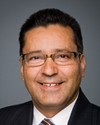Mr. Chairman and members of the committee, thank you for the opportunity to address this committee on this issue.
We've had the opportunity to serve on the ad hoc committee on medical isotopes. As Dr. Urbain mentioned, as a group of physicians representing the CAR, we were recently put on this committee.
The Canadian Association of Radiologists is the national voice of radiology committed to promoting highest standards in patient-centred imaging, lifelong learning, and research. We are also radiologists as an integral part of the health care team.
The CAR has been monitoring the effects of the Chalk River shutdown, as a prolonged shortage of medical isotopes has implications for radiology services across the country. Patients needing nuclear medicine scans may be required to move to other imaging modalities for their diagnoses and treatment monitoring, notably CT and MRI.
The effect on an already stressed imaging system with long waiting lists for CT and MRI can be significant. The availability of PET and CT PET scanners varies widely, but relatively few are available in Canada to meet the increased demand.
Provinces and territories individually manage their own isotope supplies. Therefore the effect of a shortage differs across the country. The CAR is trying to monitor any increased demand for radiology through its provincial organizations, and no change has been detected in just the last few weeks.
There is a need to maximize collaboration in Canada among provincial, territorial, and federal governments, health care authorities, and medical organizations as this shortage continues.
The CAR believes a coordinated national standard and strategy would ensure that the needs of all Canadian patients from coast to coast are at the forefront as we manoeuvre through a limited supply of medical isotopes. Perhaps a pan-Canadian committee might collectively manage the issue and develop strategies that address the best interests of all Canadians in the short and long term.
Such a committee would need to be comprised of representatives from and have mechanisms in place to seek input from provincial, territorial, and federal governments; provincial and territorial health care authorities; national and provincial imaging associations; colleges and educational institutions that provide health and human resources; and finally, but not least, the industries that are producing or distributing the isotopes.
Only through a concerted effort of government, medicine, and industry will Canada successfully navigate this critical health care situation. The CAR is willing to play a key role in this committee.
Coordinated consultation with imaging groups, accommodating more imaging studies in an already stretched medical imaging system, will require a detailed assessment and consultation with other imaging groups. This would include groups such as the Canadian Association of Medical Radiation Technologists, their representatives being here, and the Canadian Society of Diagnostic Medical Sonographers, in consideration of the impact of increased demand on technologists' manpower and training. CAR is willing to play a role in this kind of needed consultation.
In developing short-, mid-, and long-term strategies, it is critical that Canadians have access to required nuclear medicine services. This will require immediate action. The CAR identifies numerous areas it sees as requiring attention and in which the CAR might assist in managing the current isotope shortage.
First, we could assist in a comprehensive study on the realistic impact of how decreased supply worldwide will impact Canada. How many patients with no access to nuclear medicine tests would be affected? How many of these could and would be transferred to radiology imaging? What would be needed to accommodate these patients? Could increased workload be accommodated with the current system? If so, for how long and at what degree? Could we and how would we expand the operating time of facilities to impact patient needs? What would be the impact on staff, both physicians and technologists? Finally, who would absorb all these new costs for both capital and operating?
Secondly, we need to assess and monitor the effect of a prolonged isotope shortage on radiology demand and workload. Adjusting workload and manpower supply to optimize the use of isotopes and shifting imaging examinations to other nuclear or non-nuclear modalities, such as CT and MRI , are affected by and dependent on current imaging resources now and in the long term. Specifically, there's a need to monitor and report on the system impacts, including those. These will be useful in planning for the investment in isotope supply for the future, including staff--radiologists and technologists, their work hours, overtime, and sick leave; management; the number of units being produced in nuclear medicine radiology at facilities at the national, provincial, and regional levels; resource use; the total cost to treatment point as patients move through the system; machine use and operating time; wait times for nuclear medicine for diagnostic imaging; and ultimately cost overruns within the radiology system.
One solution we might offer is expanded use of the CAR evidence-based diagnostic imaging referral guidelines as a way to prioritize patients. Guidelines assist patients in ordering the best test first. They have a positive impact on the management of imaging, health, human, and equipment resources; patient safety through reduced exposure to unnecessary radiation; and wait times. Improved management of current imaging resources creates more capacity. The CAR now has five years of experience in implementing evidence-based and transparent diagnostic imaging guidelines with specialists, family physicians, and general practitioners, and can help expand the use of these guidelines across the country.
Next is developing clinical protocols, strategies, and algorithms for prioritizing patients based on local and regional resource availability, and developing special request forms or formats to identify these patients and assist them to monitor requests that might take into consideration already existing wait lists.
Another point is to assist in the development of a coordinated approach to assess radiology needs to ensure that all regions have fair and equitable access to available isotopes and alternative radiology services.
Next is to assist in the careful planning and coordination for the long term that will be required to avoid a similar situation in the future. The need to expand replacement technologies should be studied, such as adding more CT-PET and CT-NMR. The CAR might assist with issues to be resolved, such as how the actual demand would be met over the next five years; how many new units would be needed to meet the demand; how to deal with existing wait lists; how soon there could be a realistic increase in supply; and how we could meet the manpower needs.
Finally, managing the shortage of medical isotopes now and creating future supplies is a global, national, provincial, and territorial issue that will require collaborative efforts within and between all levels of government, health care authorities, medical associations, and industry, now and in the years ahead. Management of an isotope shortage in the short term must coincide with mid- and long-term strategies for supplies. The CAR is open to continuing involvement at each of these levels in order to assist in the evolution of isotope supply and management.
Finally, the CAR believes that beginning with a commitment to a national approach that considers the health care of each Canadian equally is an important first step on this journey.
Thank you very much.
Dr. Lévesque, our vice-president, and I will entertain questions at the appropriate time.












